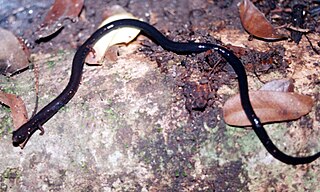Craugastor chrysozetetes is a possibly extinct species of frog in the family Craugastoridae. It is endemic to Honduras where it is only known from near its type locality on the Cerro Búfalo, Cordillera de Nombre de Dios, at the edge of the Pico Bonito National Park. Common name McCranie's robber frog has been coined for this species. However, James McCranie himself has argued that this name "should be rejected in favor of a name associated with the type locality instead of a name tied to one of the three authors who named this species".
Pristimantis tribulosus is a species of frog in the family Strabomantidae. It is endemic to Colombia and is only known from the vicinity of its type locality near Samaná in the Caldas Department, on the eastern slope of the Cordillera Central. The specific name tribulosus, meaning "thorny", refers to the numerous tubercles that cover the upper surfaces of this species.
Phrynopus montium is a species of frog in the family Strabomantidae. It is endemic to Peru and only known from two localities near Cascas in the Junín Region: "Cascas near Huasahuasi", the imprecisely known type locality where the types were collected in 1936, and south of Hacienda Cascas, where it was found in 2014. Records from the PascoPasco and Huánuco Regions refer to Phrynopus kotosh and Phrynopus oblivius, respectively. Common name Cascas Andes frog has been coined for this species.
Telmatobius halli is a species of frog in the family Telmatobiidae. It is endemic to northern Chile and only known from its type locality near Ollagüe. The specific name halli honors Frank Gregory Hall, an American specialist on the effects of high altitudes on human body and collector of the type series. Its common name is Hall's water frog.
The Guaramacal salamander, also known as the holy-mountain salamander, is a species of salamander in the family Plethodontidae. It is endemic to the Cordillera de Mérida, Venezuela. The Venezuelan specimen first reported as Bolitoglossa savagei likely represents this species. The species is named after its type locality, Guaramacal in the Trujillo.
Bolitoglossa oresbia is a species of salamander in the family Plethodontidae. It is endemic to Honduras and is known from the summit of Cerro El Zarciadero and the southwestern side of the nearby Cerro Azul Meámbar National Park, in the northern Comayagua Department.
Cryptotriton monzoni is a species of salamander in the family Plethodontidae. It is endemic to Guatemala and known only from near its type locality, Cerro del Mono near La Unión, Zacapa Department. The specific name monzoni honors José Monzón, a Guatemalan entomologist who helped the authors with the fieldwork. Common name Monzon's hidden salamander has been coined for it.
Cortes salamander is a species of salamander in the family Plethodontidae. It is found in the Sierra de Omoa in northwestern Honduras and Sierra de Caral in eastern Guatemala, close to the border with Honduras. The vernacular name Cortes salamander refers to the Cortés Department where the type locality is located, whereas the alternative name Cortez' hidden salamander with the spelling "Cortez" and the apostrophe are errors.
Oedipina carablanca, commonly known as the Los Diamantes worm salamander, is a species of salamander in the family Plethodontidae. It is endemic to Costa Rica and is only known from its type locality, Los Diamantes, near Guápiles, Limón Province.

Oedipina cyclocauda, commonly known as the Costa Rica worm salamander, is a species of salamander in the family Plethodontidae. It is found on the Caribbean slopes of northwestern Panama, eastern Costa Rica, Nicaragua, and northern Honduras. The specific name cyclocauda refers to the circular caudal grooves.

Oedipina gephyra, commonly known as the La Fortuna worm salamander, is a species of salamander in the family Plethodontidae. It is endemic to Honduras.
Oedipina maritima, commonly known as the maritime worm salamander, is a species of salamander in the family Plethodontidae. It is endemic to Isla Escudo de Veraguas, Panama.
Oedipina stuarti, commonly known as Stuart's worm salamander, is a species of salamander in the family Plethodontidae. It is endemic to Honduras.

Oedipina taylori, commonly known as Taylor's worm salamander, is a species of salamander in the family Plethodontidae. It is found on the Pacific versant in south-eastern Guatemala, to central to north-eastern El Salvador and adjacent southern Honduras. Honduran populations might represent another species.
Pseudoeurycea aquatica, which has been given the common name of aquatic salamander is a species of salamander in the family Plethodontidae. It is endemic to Mexico and only known from its type locality in the Sierra Madre de Oaxaca near Totontepec Villa de Morelos, Oaxaca.
Bolitoglossa nussbaumi is a lungless salamander in the family Plethodontidae endemic to Guatemala.

Bolitoglossa cataguana, also known as the Cataguana salamander, is a species of salamander in the family Plethodontidae. It is endemic to Honduras and known from near Cataguana in the Marale municipality, Francisco Morazán Department.

Oedipina tomasi is a small, lungless salamander in the family Plethodontidae. This critically endangered amphibian has only ever been observed in the Cusuco National Park in Honduras. Very few specimens have been observed in the wild.
Chiropterotriton casasi, also known as the Tlapacoyan salamander, is a species of salamander in the family Plethodontidae. It was last seen in 1969, and is possibly extinct.





